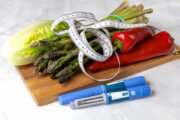Protein for health
Over the past couple decades, nutritional science has evolved. Where once low-fat and high-carbohydrate diets were thought to be best, lately diets that emphasize higher protein levels have gained a lot of traction as the way to go for weight loss and overall improved health and wellness.
Protein is a macronutrient that’s essential to building muscle. It can be derived from a number of sources, both animal and plant. The U.S. Recommended Dietary Allowance for protein is 0.8 grams of protein per kilogram of body weight, so a 165-pound adult would need about 60 grams of protein per day.
Best sources of protein
Many foods contain protein — and you should seek to include a variety of these to ensure you’re getting not just protein, but also a variety of other nutrients — vitamins and minerals — you need as well.
Read on to learn about the seven healthiest sources of protein.
1. Fatty fish
Cesar Sauza, clinical nutrition manager, health education and wellness at AltaMed Health Services in Los Angeles, says his “top go-to protein foods sources” are fatty fish including salmon, tuna and sardines.
— A 3-ounce serving of tuna steak contains 24 grams of protein.
— A 3-ounce serving of Atlantic salmon contains 17 grams of protein.
In addition to lots of protein, these fatty, cold water fish are also excellent sources of omega-3s, which are fatty acids that the body uses to maintain a range of processes, including eye and brain health and heart and circulatory health.
Specifically, fatty fish are good sources of two particular omega-3 fatty acids called DHA and EPA, which “are tied to overall brain and cardiovascular health,” Sauza says. Studies have shown that people who eat at least two servings of fatty fish per week consistently have a decreased risk of heart disease and neurogenerative disease.
“Unfortunately, DHA and EPA are not usually found in plant sources other than algae,” which you can add via a supplement, he says. But, if you don’t eat any meat or don’t like seafood, you can get those omega-3s from supplements.
2. Eggs
“When not eating seafood, I look to non-meat, animal-based proteins such as cage-free eggs,” Sauza says. One large hard-boiled egg contains 6 grams of protein.
Eggs are also a good source of a variety of vitamins and minerals including:
— Vitamins B2, B5, B6 and B12.
— Folate.
— Phosphorous.
— Selenium.
Janine Souffront, health educator supervisor for L.A. Care Health Plan, the largest publicly operated health plan in the country, says she likes “eggs for their ease of preparation and versatility.”
Indeed, there are a whole host of ways to prepare eggs and include them in dishes from a simple hard-boiled egg that you can toss into a salad or a more complex omelet or frittata meal. They’re fast, easy and a great way to get a lot of nutrition from a single source.
3. Beans and legumes
Souffront says that legumes are “my personal go-to protein foods. Not only are they high in protein, but also rich in fiber, minerals, vitamins, antioxidants and resistant starch,” a type of carbohydrate that, like fiber, is difficult to digest and can help you feel fuller longer.
Resistant starches can also improve blood sugar levels and insulin sensitivity, which can help reduce the risk of developing Type 2 diabetes.
Beans and legumes are vegetarian staples because they provide a lot of protein and good, heart-healthy nutrition in an inexpensive package. Beans and legumes are great sources of:
— Fiber.
— Iron.
— Potassium.
Some of the best options for a protein punch include:
— Soybeans. Also called edamame, a cup of boiled soybeans contains 31 grams of protein.
— Lentils. A cup of lentils contains about 18 grams of protein.
— White beans. A cup of large white beans, such as Great Northern beans, contains about 17 grams of protein.
— Split peas. Peas are members of the legume family, and a cup of split peas contains more than 16 grams of protein.
— Kidney beans. A cup of kidney beans contains about 15 grams of protein.
— Black beans. A cup of black beans also contains about 15 grams of protein.
— Lima beans. Lima or butter beans pack nearly 15 grams of protein into a cup.
“Canned legumes are almost just as good as the ones you cook yourself,” Souffront adds, and they’re much quicker to prepare.
4. Dairy products
Greek yogurt and kefir are both rich sources of protein that also offer a gut health boost because they’re fermented and contain probiotics. Probiotics are microorganisms that live in the gut and can influence a wide range of conditions and overall health.
Kailey Proctor, a board-certified oncology dietitian at the Leonard Center Institute at Providence Mission Hospital in Mission Viejo, California, notes that “Greek yogurt has almost twice the protein as regular yogurt.” It’s also “high in calcium and is often fortified with vitamin D, so it’s a great option for keeping bones strong.”
Sauza recommends opting for “low-fat and plain or low-sugar options” of yogurt or kefir to keep calories down and excess sugar out of your diet.
Souffront also recommends yogurt and kefir because “they’re ready to eat or drink at any time.”
Proctor agrees, adding that “Greek yogurt is a portable breakfast option and research indicates those who consume a high-protein breakfast weigh less.”
Cottage cheese is also a good source of protein that’s low in calories relative to its protein content. Again, low-fat and no-sugar added options are preferable to ones that contain added flavors or sweeteners.
— A single container (170 grams) of plain, nonfat Greek yogurt contains 17 grams of protein.
— A cup (8 ounces) of plain, whole milk kefir contains 9 grams of protein.
— One cup of low-fat cottage cheese contains 28 grams of protein.
5. Seeds
Sauza swears by seeds, a good source of plant-based protein and omega-3 fatty acids. “Seeds are underrated and often overlooked compared to nuts, however, many times they’re cheaper and arguably provide more overall nutrient value.”
He adds that while seeds aren’t typically thought of as a high source of protein, “they do provide protein along with another omega-3 called ALA.” You need ALA just like you do DHA and EPA.
“Seeds are also fiber-rich and provide us with a variety of vitamins and minerals.” In other words, when you eat seeds, you’re getting a wide range of nutritional value from a plant-based source.
He recommends adding hemp seeds, chia seeds, pepitas and quinoa — which is typically treated like a grain when cooked — to meals and dishes for an added protein punch.
— A 30-gram serving (about three tablespoons) of raw hemp seeds contains about 9 grams of protein.
— A 1-ounce (about 28 grams) serving of chia seeds contains 4.7 grams of protein.
— A cup (or 64 grams) of pepitas, which are pumpkin seeds, contains 12 grams of protein.
— A cup of cooked quinoa contains 8 grams of protein.
6. Nuts
Nuts are a fatty food high in protein with a delicious crunch that can be a healthful addition to your diet. Almonds, peanuts, pistachios, walnuts and cashews all provide a range of nutrients and high protein levels that taste delicious.
Almonds in particular are a good choice, Proctor says.
— A 1-ounce (1/4 cup) serving of almonds has 6 grams of protein.
Almonds are also high in “heart-healthy monounsaturated fat. This type of fat helps reduce the risk of heart disease and may help lower LDL cholesterol,” that’s the “bad” cholesterol that’s been implicated in heart disease.
What’s more, Proctor notes that “the fat in almonds also helps our bodies absorb other fat-soluble vitamins like vitamins A, D, E and K.”
And almonds are portable and easy to have on hand when you need them. “You can throw them in your purse or keep them at your desk.
“For a quick snack, a few nuts can do the trick, and you get some healthy fats along with the protein,” Souffront says.
Just be careful if you’re adding nuts to your diet, as they contain high levels of fat and thus are high in calories, Proctor says. Almonds contain about 170 calories per ounce, “so it’s important to watch portion sizes for weight maintenance.” Don’t overdo it.
7. Meat
Sauza says that while animal meats such as beef, pork, chicken and turkey are all good sources of protein, he uses them the least. “I advise including some of the vegetarian sources of protein” instead of only focusing on meat because they offer additional health benefits and are often less expensive than meat proteins.
— A skinless, cooked chicken breast (roughly 172 grams) contains 54 grams of protein.
— A 3-ounce serving of beef contains 22 grams of protein.
If you’re going to include animal meats, Sauza recommends focusing on lean, white meats like skinless chicken breast or turkey and avoiding processed meats and fried meats such as:
— Ham.
— Bacon.
— Hot dogs.
— Sausage.
— Deli meats.
Another thing to consider is how the animal was treated when it was alive, he adds. “The key here is where these animal meats are coming from and how these animals were raised. I recommend using grass-fed beef, organic free-range chicken and wild-caught seafood” rather than their conventionally farmed counterparts or red meat or processed meats.
The healthiest, protein-rich foods:
1. Fatty fish, such as salmon and tuna.
2. Eggs.
3. Beans and legumes, such as lentils and soybeans.
4. Dairy products, such as Greek yogurt and cottage cheese.
5. Seeds, including hemp and chia.
6. Nuts, especially almonds.
7. Meat, such as skinless chicken breast.
More from U.S. News
Foods to Help Conquer Your Cravings
7 Top Healthy Protein-Rich Foods originally appeared on usnews.com
Update 11/30/21: This story was published at an earlier date and has been updated with new information.







